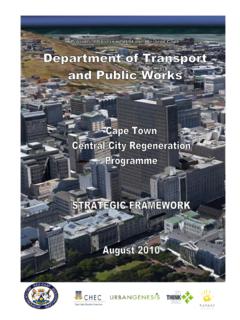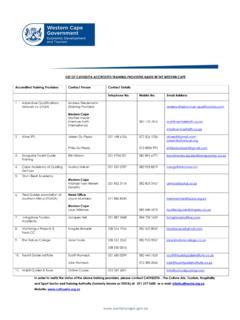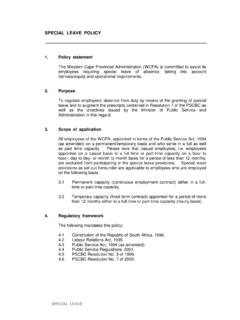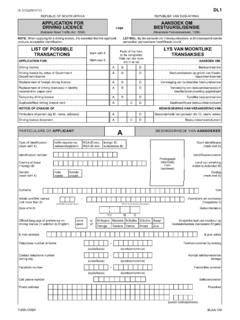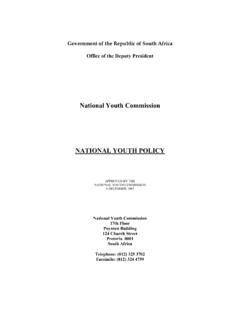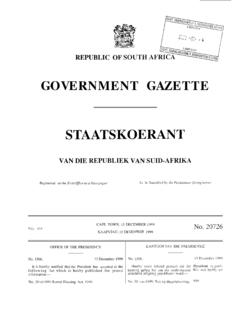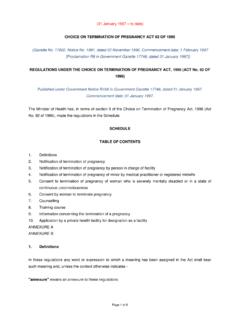Transcription of GUIDELINE FOR ENVIRONMENTAL - Western Cape
1 GUIDELINE FOR ENVIRONMENTAL . MANAGEMENT PLANS (EMPs). Issued by: Provincial Government of the Western Cape Department of ENVIRONMENTAL Affairs and Development Planning Utilitas Building, 1 Dorp Street Private Bag X9086. Cape Town 8000. South Africa Prepared by: Paul Lochner CSIR Environmentek P O Box 320. Stellenbosch 7599. South Africa Email: Tel: 021-888 2486. Fax: 021-888 2693. COPYRIGHT Republic of South Africa, Provincial Government of the Western Cape, Department of ENVIRONMENTAL Affairs and Development Planning 2005. ALL RIGHTS. RESERVED. This document is copyright under the Berne Convention. Apart from the purpose of private study, research or teaching, in terms of the Copyright Act (Act No. 98 of 1978) no part of this document may be reproduced or transmitted in any form or by any means, electronic or mechanical, including photocopying, recording or by any information storage and retrieval system, without permission in writing from the Department of ENVIRONMENTAL Affairs and Development Planning.
2 Likewise, it may not be lent, resold, hired out or otherwise disposed of by way of trade in any form of binding or cover other than that in which it is published. This GUIDELINE should be cited as: Lochner, P. 2005. GUIDELINE for ENVIRONMENTAL Management Plans. CSIR Report No ENV-S-C. 2005-053 H. Republic of South Africa, Provincial Government of the Western Cape, Department of ENVIRONMENTAL Affairs & Development Planning, Cape Town. ACKNOWLEDGEMENTS. ACKNOWLEDGEMENTS. Internal review: Dr Mike Burns - CSIR Environmentek Ayub Mohammed - DEA&DP. Washiela Anthony - DEA&DP. Independent peer review: Dr Andrew Spinks - Ninham Shand Key references that informed the GUIDELINE : This GUIDELINE has been primarily informed by the following documents (refer to References for details): DEAT Integrated ENVIRONMENTAL Management Information Series, in particular the documents Overview of IEM (no.)
3 O), Stakeholder Engagement (no. 3), ENVIRONMENTAL Management Plans (no. 12), ENVIRONMENTAL Auditing (no. 14), Linking EIA and EMS (no. 20). and ENVIRONMENTAL Monitoring Committees (no. 21). guidelines for standardised ENVIRONMENTAL Management Plans for projects within the water resource management component of the Department of Water Affairs and Forestry, prepared for DWAF by CSIR in 2002. ENVIRONMENTAL Management Programme (Version 5) for Civil Engineering Construction Activities, published by the City of Cape Town in 2002. Finalisation of report figures and formatting: Magdel van der Merwe and Elna Logie, DTP Solutions DEA&DP GUIDELINE FOR ENVIRONMENTAL MANAGEMENT PLANS. page i PREFACE. PREFACE. The Department of ENVIRONMENTAL Affairs and Development Planning (DEA&DP) of the Western Cape Government is in the process of publishing a series of guidelines related to ENVIRONMENTAL assessment and management.
4 The overall purpose of these guidelines is to improve the efficiency, effectiveness and quality of ENVIRONMENTAL assessment and management processes. At present, the following guidelines have been prepared: GUIDELINE for determining the scope of specialist involvement in EIA processes GUIDELINE for the review of specialist input in EIA processes GUIDELINE for involving biodiversity specialists in EIA processes GUIDELINE for involving hydrogeologists in EIA processes GUIDELINE for involving visual and aesthetic specialists in EIA processes GUIDELINE for involving heritage specialists in EIA processes GUIDELINE for involving economists in EIA processes GUIDELINE for ENVIRONMENTAL Management Plans. Although these guidelines have been developed with specific reference to the Western Cape Province of South Africa, their core elements are more widely applicable.
5 DEA&DP GUIDELINE FOR ENVIRONMENTAL MANAGEMENT PLANS. page ii SUMMARY. SUMMARY. An ENVIRONMENTAL Management Plan (EMP) Includes the enhancement of positive can be defined as an ENVIRONMENTAL impacts (benefits) as well as the management tool used to ensure that mitigation of negative impacts; and undue or reasonably avoidable adverse impacts of the construction, operation and Should not be viewed as a prescriptive decommissioning of a project are and inflexible document. prevented; and that the positive benefits of the projects are enhanced . EMPs are The GUIDELINE for EMPs describes the therefore important tools for ensuring that envisaged scope and content of an EMP, the management actions arising from covering both the preparation and ENVIRONMENTAL Impact Assessment (EIA) implementation stages of an EMP process, processes are clearly defined and as well as the roles of key stakeholders implemented through all phases of the associated with EMPs.
6 To assist in the project life-cycle. review of EMPs by the authorities, as well as other reviewers, a set of review criteria The overall purpose of the GUIDELINE is has been identified. It must emphasized that twofold: to inform and guide the preparation these criteria are not intended to provide a and implementation of EMPs in a manner prescriptive list of requirements for each that promotes the effectiveness of EMPs; and every EMP, but to provide prompts for and to assist authorities and other reviewers reviewers regarding the scope and level of in objectively evaluating the quality of detailed appropriate for an EMP. EMPs. This GUIDELINE for EMPs describes the key components that should be included Looking ahead, EMPs provide an essential in an EMP, drawing from relevant existing tool for ensuring that the mitigation of guidelines as well as South African EMP negative impacts and enhancement of experience.
7 Positive impacts is carried out effectively during the project life-cycle. It is therefore Key features of this GUIDELINE are that it: intended that this GUIDELINE be used in the spirit of continual improvement, to assist in Is applicable to a range of types and promoting best practice in ENVIRONMENTAL scales of projects or developments, from management, in a manner that is pragmatic, projects with a low level of efficient and cost-effective. ENVIRONMENTAL risk to those with high ENVIRONMENTAL risk;. Assumes a broad understanding of the term environment , that includes the biophysical, social and economic components;. DEA&DP GUIDELINE FOR ENVIRONMENTAL MANAGEMENT PLANS. page iii CONTENTS. CONTENTS. Acknowledgements ..i Preface ..ii Summary .. iii 1. INTRODUCTION_____ 1.
8 Need for this GUIDELINE _____ 1. Purpose and scope of this GUIDELINE _____ 2. Target audience _____ 3. How to use this GUIDELINE _____ 3. 2. OVERVIEW OF ENVIRONMENTAL MANAGEMENT PLANS _____ 3. Over-arching objectives of an EMP_____ 4. Generic scope of an EMP _____ 4. Triggers for an EMP _____ 4. EMP within the context of IEM _____ 6. Phasing of the EIA and EMP_____ 8. Linking EMPs with ENVIRONMENTAL management systems _____ 8. Adjusting EMPS to project scale and context _____ 10. 3. PREPARATION AND IMPLEMENTATION OF THE EMP_____ 10. Background information required to prepare the EMP _____ 10. Preparation of an EMP _____ 12. Implementation of the EMP_____ 21. 4. PRINCIPLES UNDERPINNING EMPs _____ 26. Principles of sustainable development _____ 26. Principles for ethics and quality_____ 27.
9 Principles specific to EMPS _____ 27. 5. ROLES OF KEY STAKEHOLDERS_____ 28. Project proponent _____ 28. Contractors _____ 30. Lead authority _____ 31. Other authorities _____ 32. Interested and affected parties _____ 34. Financial institutions or donors _____ 34. ENVIRONMENTAL monitoring committee _____ 34. Independent ENVIRONMENTAL consultant _____ 34. 6. REVIEWING EMPs_____ 35. Scope and timing of the review _____ 35. Information required for the review _____ 35. DEA&DP GUIDELINE FOR ENVIRONMENTAL MANAGEMENT PLANS. page iv CONTENTS. Review criteria_____ 36. 7. CONCLUSIONS _____ 40. 8. REFERENCES _____ 41. Appendices Appendix A: Definitions And 43. Appendix B: Overview of the ENVIRONMENTAL Management Programme for Civil Engineering Construction Activities prepared by the City Of Cape Town.
10 45. Appendix C: Example of how the links between objectives, management actions, monitoring, criteria/targets and remedial actions can be presented using a tablular 47. List of figures Figure 1: Context of EMPs within wider ENVIRONMENTAL assessment and management processes .. 7. Figure 2: The ISO14001 approach to ENVIRONMENTAL Management Systems .. 9. Figure 3: Example of how communications channels and responsibilities can be structured for a construction 33. List of tables Table 1: Features of projects with low or high ENVIRONMENTAL 11. Table 2: Review criteria for 36. List of boxes Box 1: Objectives of mitigation actions aimed at reducing adverse impacts .. 16. Box 2: Requirements for determining whether management actions are clearly defined .. 16. Box 3: Example of the scope of management actions typically required for construction of a new large-scale industrial project.

